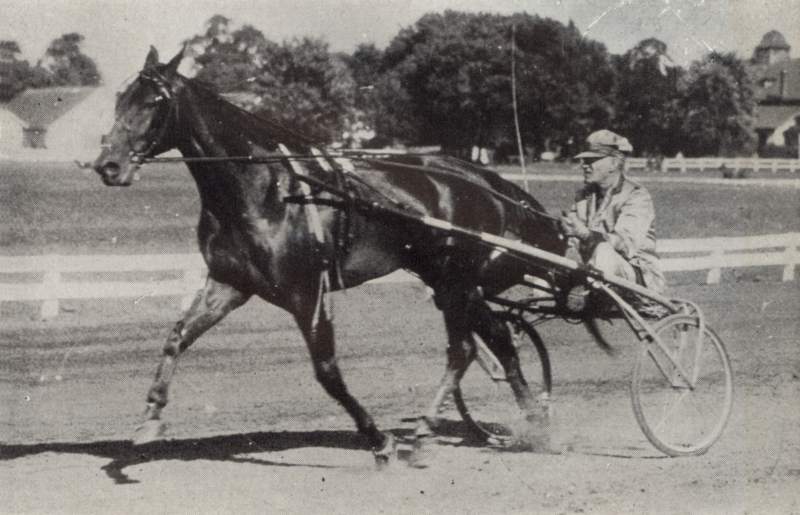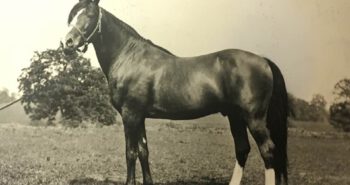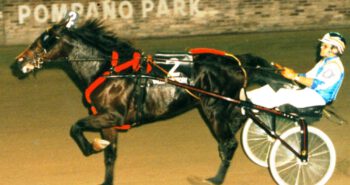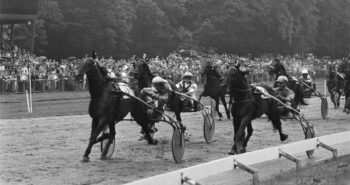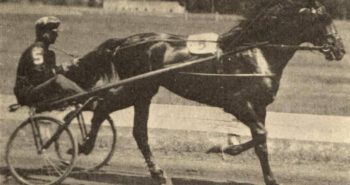Volomite is generally considered one of the best stallions in trotting history. It’s important to remember, though, that Volomite was only the second best in his crop on the track. However, while Volomite proved his worth at stud in safe surroundings in the US, quite the opposite was the case with his superior, Walter Dear, who eventually was trapped in a war-torn Germany.. This is the story of the only Hambletonian winner in history whose fate is unknown.
Walter Dear was bred and owned, until he was exported, by William Cane’s Good Time Stables located in Goshen. Cane would often name horses horses for his friends and acquaintances. The horse got his name from publisher Walter Moore Dear, who published the Jersey Journal from 1908 to 1948. The four-legged Walter Dear established his dominance in the 1926 crop early on and came into the Hambletonian fresh off winning the Kentucky Futurity in straight heats the previous week – because of rainouts, the second time in three years, the Hambletonian had been postponed until October 8 and moved Lexington that year.
A winner of his six previous races, the Hambletonian was in the eyes of most people a foregone conclusion. Even though some believed Volomite could possibly stage an upset, it turned out exactly as most people had predicted, with two easy heat wins for Walter Dear. This victory made the colt historic as he was the first from Peter the Great’s sireline to win the Hambletonian.
Sold to Europe
Shortly after the Hambletonian win Cane was offered $25,000 for Walter Dear by the German duo Bruno Cassirer and Arthur Brümmer. Cassirer, an art dealer and owner of a publishing house in Germany, had personally saved the Berlin’s Mariendorf racetrack from going bankrupt in 1913 by assuming personal responsibility for all debts and displaying great leadership skills by modernizing the organization and also getting rid of internal unrest in the Berlin and German trotting community. Cassirer llso owned the stud farm Gestüt Lindenhof just north of Templin, around 80 kilometers (50 miles) north of Berlin, not too far from the Polish border. Previously owning a farm in Damsbrück, Cassirer had bought Lindenhof in 1931. It was an impressive facility. A 1000 meter (5/8 mile) training track was constructed and champion trainer Charlie Mills established his operation here. In 1933 Cassirer sold the facilities, at least in name, to Charlie Mills, but in reality he had no choice. After all, Cassirer was Jewish and with Hitler’s rise to power in that year it became increasingly difficult to own property and run a business. He would continue to try for a few more years, but in 1936 his publishing house lost the right to publish and in 1938 Cassirer fled with his family to England. He passed away in Oxford in 1941, 68 years old.
Cassirer had also tried to purchase another US star, Hazleton, but he ended up with Otto Dieffenbacher in Milan, Italy. These two won many of the bigger races in Europe but did not meet too often. But when they did Walter Dear almost always emerged victorious. However, being very close in speed and abilities, the races were usually won by the narrowest of margins. Walter Dear’s ability to leave faster than Hazleton, however, often gave him a positional advantage. In heat after heat Hazleton lost by a short margin to Walter Dear after having to trot outside all the way. On several occasions the Hazleton people claimed that luck and the rail position were the only reasons Walter Dear managed to win.
One of their most memorable battles took place in the 1931 Copenhagen Cup, an Invitational race which is the precursor to the current Copenhagen Cup. It was a clash of titans: Hazleton came into the race with 13 straight wins while Walter Dear had lost once in his last 12 starts. The duel between Hazleton and Walter Dear was such a big happening that even the Danish king Christian X attended – his first and supposedly only visit ever to the Copenhagen racetrack. Walter Dear won in the first heat in 1.18,4 (2:06.1) and the second in 1.19,7 (2:08 1/4), the first heat time being the fastest by any trotter in Scandinavia. In both heats Walter Dear had managed to get to the lead and although accepting the defeat, the Hazleton party contended that if the positions had been switched, the outcome would be different. To illustrate the level the duo performed at: Walter Dear’s winning time of 1.18,4 stood for 20 years until Muscletone’s younger brother Rollo finally lowered it in 1951.
From Copenhagen the two fighters travelled to Berlin for the Matadoren Rennen, the biggest European race outside of France at that time. From Edwin Koch’s article in the 1957 Christmas edition of the Danish magainze Travtidende, “here Walter Dear won yet again, but what kind of winner was he? Walter Dear won the first heat and the second heat, won in 1.18,2 (2:05.4f), was a dead heat, which means that Walter Dear won the race. Photo finishes were an unknown thing back then. Almost everybody present thought Hazleton was the winner, and I still remember that I shortly after the race met Otto Halling, a judge at the Charlottenlund racetrack (note: in Copenhagen, Denmark). ‘I might have been strung up from a lamp post had I issued that kind of result’, was his sarcastic comment.”
Walter Dear impressed all over Europe. He won the 1934 Prix d’Amerique. He won the Matadoren-Rennen, the biggest race in Germany, three years in a row. Another big German race, the Preis von Deutschland, was won twice. In the 1933 edition of that race, Walter Dear was given a 140 meter (153 yard) handicap but still managed to win! His race record from the 1933 race stood for 24 years until another Charlie Mills horse, the legendary Gelinotte, finally broke it in 1957. Walter Dear lost the 1932 edition to another US import, Legality, who he usually beat. He didn’t win the biggest races in Italy, simply because he didn’t start in them – but the son of Laurel Hall still impressed the Italian trotting public. On Boxing Day 1933 he lost Premio d’Inverno in Milan to the excellent US-bred Topsy Hanover but put in a spectacular performance worthy of a champion. Walter Dear had a 60 meter handicap and made it even more challenging for himself by breaking and losing another 30 meters. Chasing down the field and then going around, the second lap in a 1.17-tempo (2:05-rate), Walter Dear almost managed to catch Topsy Hanover, but as he was just a length behind her in the final stretch he broke again. Topsy Hanover won in 1.21,2 (2:10.3) over 2040 meters (slightly more than 1 1/4 mile). Walter Dear and Mills returned empty-handed to Germany, but not without receiving a lot of credit in Italian newspapers.
The Derby sire
While Hazleton continued to race until a very advanced age, Walter Dear was retired to stud at 9. He had bred a few mares before then, however, and his first foal, Probst, was almost as spectacular as his sire. Probst won everything in his crop and became one of the first German born international stars. It did not take long for Walter Dear to prove his worth at stud. A quick look at the winners of the German Derby tells the story. In his first 8 crops he produced 5 derby winners (1935, 1939, 1940, 1941 and 1942). He was champion stallion in Germany each year from 1939 to 1943. Clearly he was one of the best, if not the best, stallions in Europe. One can only imagine what he would have produced had he been give the same kind of mares that Volomite received year in and year out at Walnut Hall farms, and, just as importantly, not be surrounded by war. There is every reason to believe that Walter Dear would have given Volomite a very good run for his money had he stood stud in the US, though that is just speculation.
Taken by Soviet soldiers
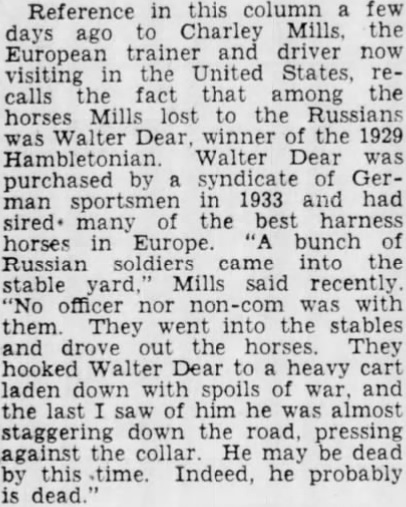
In addition to Lindenhof, Charlie Mills also owned the Staffelde farm just outside of Berlin and it was from here that Walter Dear and around 20 other horses were taken toward the end of the war. Among the other horses taken were the star Probst and Missouri, both Derby winning sons of Walter Dear. Another horse who disappeared was the aging broodmare Ethelinda, dam of Hambletonian winner McLin Hanover who had been imported to Germany in the late 30s. (Ethelinda was bred to Walter Dear and produced the good trotter Ethawa who survived the war.)
As luck would have it, Missouri was actually recovered and became a useful stallion after the war, but he was the only one that was found and can be accounted for. Several attempts were made to figure out the fate of the other horses but nothing could ever be ascertained.
Charlie Mills later explained that Soviet soldiers came to the farm and left with Walter Dear and several other horses. We know that Walter Dear and the others disappeared when the Red Army steamrolled towards Berlin. The four prevailing theories are that he was either (1) slaughtered and eaten by starving Russian soldiers, (2) used by Russian army for transport, (3) taken to Soviet trotting farm to do stud duty or (4) died as a casualty of combat. Unfortunately, the first alternative seems the most likely, as a good horse was a prized possession toward the end of WWII. Some have theorized that he may have been sold on the black market but that sounds unlikely since there isn’t a functioning black market for trotters on the frontline of a war, nor is it likely that any Soviet soldier would even know about Walter Dear.
At that time and given the circumstances it seems unlikely that the soldiers even knew who they had in their possession, nor that they focused too much on about his breeding value. One can speculate page up and page down, but the only thing that we know for sure is that we will never know the fate of Walter Dear.
Walter Dear
Bay colt born in Goshen, NY in 1926. Disappeared from Staffelde, Germany in May 1945.
The Laurel Hall – Blitzie (Walnut Hall)
3, 2:02 3/4 (1.16,3)
Breeder: Good Time Stables
Owners: Good Time Stables – Bruno Cassirer & Arthur Brümmer – Charley Mills
Trainers: Walter Cox and Charley Mills
Drivers: Walter Cox and Charley Mills
Groom: –

